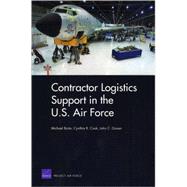
| Preface | p. iii |
| Figures | p. ix |
| Tables | p. xi |
| Summary | p. xiii |
| Acknowledgments | p. xix |
| Abbreviations | p. xxiii |
| Introduction | p. 1 |
| Maintenance of Weapon Systems and the Use of Contractor Logistics Support | p. 1 |
| Purpose of This Monograph | p. 4 |
| Research Approach | p. 5 |
| Organization of This Monograph | p. 7 |
| Chapter 2 | p. 9 |
| Background | p. 10 |
| Key Laws Affecting CLS Use | p. 10 |
| Key DoD Directives and Instructions That Affect CLS | p. 12 |
| Key Air Force Direction That Affects CLS | p. 13 |
| Implications of Laws and Regulations That Affect CLS Use | p. 15 |
| Chapter 3 | p. 17 |
| Findings and Observations: CLS Funding and Costs | p. 18 |
| How Does the Air Force Define CLS for Funding and Costing? | p. 18 |
| What Programs Use CLS, and How Much Does Each Spend on CLS? | p. 24 |
| Programs That Account for the Growth in CLS Over the Last Seven Years | p. 26 |
| What Are the Key Cost Drivers for CLS? | p. 29 |
| Observations and Conclusions About CLS Funding and Costs | p. 33 |
| Chapter 4 | p. 35 |
| Cost and Performance: Comparing CLS with Organic Support | p. 35 |
| How Does the Government Measure CLS Performance and Using What Metrics? | p. 35 |
| What Has Contractor Cost Performance Been Like for Major Programs Using CLS? | p. 38 |
| How Effective Has CLS Proven for Major Programs Using CLS? | p. 43 |
| Discussion on CLS Supply Support | p. 45 |
| How Does CLS Price Growth Compare to Organic Cost Growth? | p. 47 |
| Do Contractors Have Inherent Advantages or Disadvantages in Performing Some Tasks? | p. 49 |
| Observations on CLS Performance | p. 51 |
| Conclusion | p. 52 |
| CLS Management | p. 55 |
| Current Processes for Choosing CLS and Ongoing CLS Management | p. 55 |
| Reasons Existing Programs Use CLS | p. 57 |
| How Are Tasks on CLS Contracts Defined and Funded? | p. 65 |
| Why Do CLS Contracts Have So Little Variable Funding? | p. 68 |
| How Much Insight Does the Government Have Into the Contractor's Costs? | p. 69 |
| How Are CLS Contract Prices Determined? | p. 72 |
| Observations on CLS Management | p. 73 |
| Implications for Cost Analysts | p. 75 |
| Funding Sources May Shift at Different Stages of Support | p. 75 |
| CLS Affects the Amounts and Proportions of Costs Reported in Non-CLS O&S Elements | p. 76 |
| The Nature and Scope of CLS Tasks Differ Among Programs | p. 76 |
| Cost and Cost Growth | p. 77 |
| Some CLS Costs Are Accounted for Differently Than Are the Corresponding Organic Costs | p. 78 |
| It Is Difficult to Generate Cost-Estimating Relationships for Total System O&S Costs Because Funding Constraints Affect Much of the Total Cost | p. 78 |
| Summary and Recommendations | p. 81 |
| Summary of Findings | p. 81 |
| Recommendations | p. 82 |
| Require Centralized Decisions on Buying Design and Technical Data or Use Rights to Data | p. 83 |
| Require a Uniform Format for Cost Data | p. 85 |
| Provide Centralized Guidance to Achieve Flexibility | p. 87 |
| Strengthen Centralized Expertise to Optimize CLS Use | p. 88 |
| Retain Choices for Logistics Services | p. 91 |
| Appendixes | |
| A | p. 93 |
| B | p. 99 |
| References | p. 125 |
| Table of Contents provided by Ingram. All Rights Reserved. |
The New copy of this book will include any supplemental materials advertised. Please check the title of the book to determine if it should include any access cards, study guides, lab manuals, CDs, etc.
The Used, Rental and eBook copies of this book are not guaranteed to include any supplemental materials. Typically, only the book itself is included. This is true even if the title states it includes any access cards, study guides, lab manuals, CDs, etc.